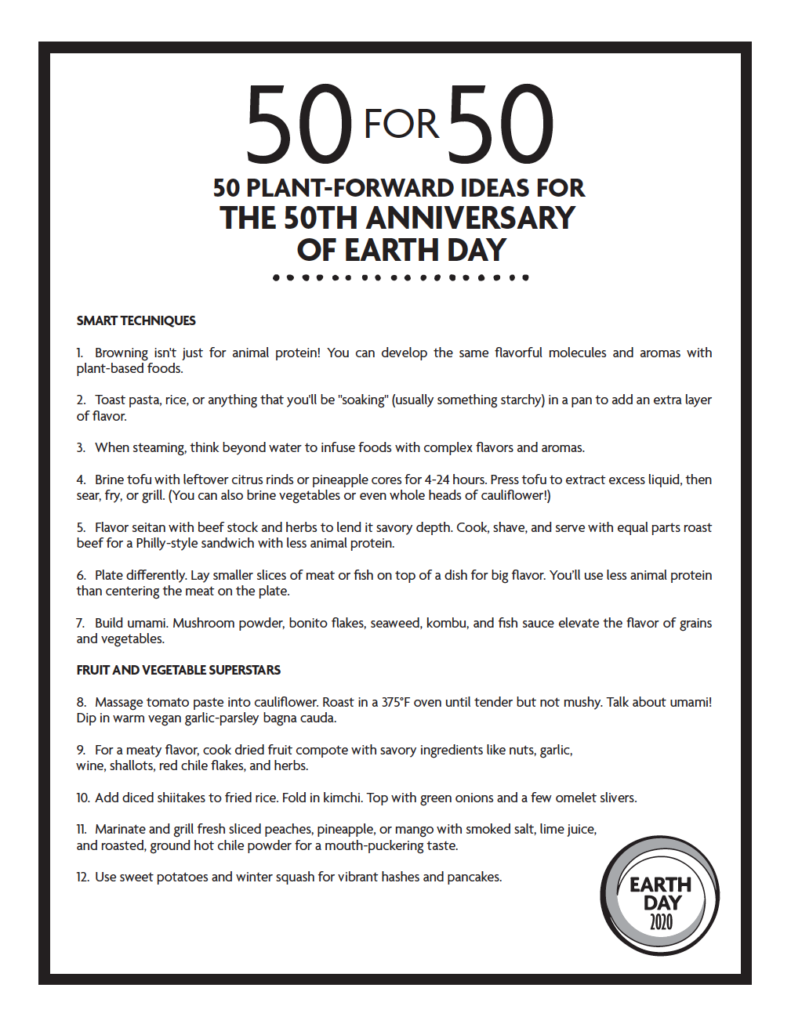
For Earth Week, Eat More Plants: 50 Plant-Forward Ideas for the 50th Anniversary of Earth Day
- by bonappetit
 This Wednesday marks the 50th anniversary of Earth Day. On April 22, 1970, 20 million Americans, in what is now recognized as the planet’s largest civic event, took to the streets to demand a new way forward for our planet, effectively creating the modern climate movement. The COVID-19 pandemic means that no one will be taking to the streets this year, but we’re still hoping everyone will join us in embracing a commitment to #plantforward eating, wherever you may be.
This Wednesday marks the 50th anniversary of Earth Day. On April 22, 1970, 20 million Americans, in what is now recognized as the planet’s largest civic event, took to the streets to demand a new way forward for our planet, effectively creating the modern climate movement. The COVID-19 pandemic means that no one will be taking to the streets this year, but we’re still hoping everyone will join us in embracing a commitment to #plantforward eating, wherever you may be.
Last year, the EAT-Lancet Commission — 37 experts in human health, agriculture, political sciences, and environmental sustainability from 16 countries — released a headline-making, in-depth report that outlined the principles for the healthy and sustainable diet that will feed a growing population of 10 billion by 2050. The Commission confirmed the philosophy that has long guided us as a company: “A diet that includes more plant-based foods and fewer animal source foods is healthy, sustainable, and good for both people and planet. It is not a question of all or nothing, but rather small changes for a large and positive impact.”
In honor of this historic anniversary, we’ve assembled 50 Plant-Forward Ideas to help you make these small changes. And starting later today, we’ll be highlighting a favorite tip or technique and sharing recipes daily.
Monday | Stem-to-Root Cooking: Pack your plate with vegetables, fight food waste — which is also a contributor to climate change — and make your groceries last longer with these creative salad recipes
Tuesday | It’s the Blend of the World as We Know It: Adding mushrooms, vegetables, and grains to your burgers and meatballs is not only healthier and tastier, but lowers their carbon foodprint
Wednesday | Get Saucy with Umami: This fifth taste, defined as “savory deliciousness,” is the secret to satisfying sauces and spreads
Thursday | Make It Grain: These hearty salads and bowls will fill you up without weighing you down.
Friday | Aquafaba Abra Cadabra!: Try one of our Earth-friendly kitchen activities for kids — making meringues with chickpea water instead of egg whites, or making these cute backyard bug snacks together!
50 FOR 50: 50 Plant-Forward Ideas for the 50th Anniversary of Earth Day
Smart Techniques
1. Browning isn’t just for animal protein! You can develop the same flavorful molecules and aromas with plant-based foods.
2. Toast pasta, rice, or anything that you’ll be “soaking” (usually something starchy) in a pan to add an extra layer of flavor.
3. When steaming, think beyond water to infuse foods with complex flavors and aromas.
4. Brine tofu with leftover citrus rinds or pineapple cores for 4-24 hours. Press tofu to extract excess liquid, then sear, fry, or grill. (You can also brine vegetables or even whole heads of cauliflower!)
5. Flavor seitan with beef stock and herbs to lend it savory depth. Cook, shave, and serve with equal parts roast beef for a Philly-style sandwich with less animal protein.
6. Plate differently. Lay smaller slices of meat or fish on top of a dish for big flavor. You’ll use less animal protein than centering the meat on the plate.
7. Build umami. Mushroom powder, bonito flakes, seaweed, kombu, and fish sauce elevates the flavor of grains and vegetables.
Fruit and Vegetable Superstars
8. Massage tomato paste into cauliflower. Roast in a 375°F oven until tender but not mushy. Talk about umami! Dip in warm vegan garlic-parsley bagna cauda.
9. For a meaty flavor, cook dried fruit compote with savory ingredients like nuts, garlic, wine, shallots, red chile flakes, and herbs.
10. Add diced shiitakes to fried rice. Fold in kimchi. Top with green onions and a few omelette slivers.
11. Marinate and grill fresh sliced peaches, pineapple, or mango with smoked salt, lime juice, and roasted, ground hot chile powder for a mouth-puckering taste.
12. Use sweet potatoes and winter squash for vibrant hashes and pancakes.
13. Make a Tex-Mex stuffed acorn squash with black beans, lime-chili slaw, tomato, pickled onion, and cashew sauce with cumin and jalapeno.
14. Stuff an avocado with cooked quinoa and farro, pumpkin seeds, capers, cilantro, lime, diced jalapeno, and 2 ounces of tuna.
15. Stir-fry carrots, broccoli, mustard greens, snap peas, and Chinese long beans with a small amount of Lap Cheong (Chinese sausage), almonds, and ginger. Aim for 95% vegetables.
Be a Blender
16. Created blended burgers, meatloaf, or meatballs subbing in heritage grains for a portion of the meat. They’ll add a nutty flavor and pleasant chew.
17. Stack your usual burger with a heap of grilled vegetables. You can reduce the size of your patty by half while boosting flavor, texture, and color.
18. Replace half the beef, pork, or chicken in a recipe with roasted, chopped mushrooms.
19. Spiralize golden beets into noodles. Serve with blended turkey/lentil bolognese.
20. For a vegetable boost, combine equal parts cauliflower rice and regular rice when making fried rice.
21. Replace half the meat with plants in bolognese, stroganoff, Shepherd’s pie, paprikash, chili, Sloppy Joes — even lasagna.
22. In a steak salad, pair 2 ounces steak with caramelized cremini mushrooms. Add black garlic salt for extra umami.
Savory Sauces
23. Make an all-vegetable “aioli” to replace the normal egg-based version. Puree cooked carrots + olive oil + herbs + garlic + your favorite spices until smooth. It’s an awesome sauce for burgers, fries, and much more.
24. Make an umami-packed vegan tapenade to drizzle over fish, slather on bread, or toss with pasta. Create a rough paste of olives + garlic + capers + parsley + lemon juice, then fold in some extra virgin olive oil.
25. Making plant-based sauces is easy. Place your favorite vegetable into a pot. Add water just to cover and a dash of salt. Bring to a boil, then simmer gently until fork-tender. Transfer the vegetable to a blender (reserve the water). Blend, adding reserved water slowly until desired consistency. Add favorite spices to amp up the flavor. Broccoli, cauliflower, carrots, peppers, tomatoes, beets, and radishes all work great!
26. For tofu stroganoff, replace the classic meat broth- and cream-based sauce with cashew sour cream. The results are creamy, nutty, and pleasingly sour, just like the original version.
27. Love Sriracha? Try harissa! It also boosts flavor, giving foods a powerful punch.
28. Add tahini to vinaigrettes and other dressings.
29. Add black garlic to vegan sauces, marinades, dips, stews, or even spice blends to up the flavor.
Smart Substitutions
30. Use olive oil instead of butter in mashed potatoes
31. Blended silken tofu with seasoning as a mayo replacement
32. Whip aquafaba with cream of tartar to reduce or replace egg whites in baked goods
33. Or use aquafaba to make vegan butter for use in hollandaise or other butter-based sauces.
34. Use plant-based milks in place of dairy in pancakes or waffle batters, or go 50/50 to reduce without replacing
Even More Inspiration
35. Combine garlic, black olives, parsley, and anchovy in a food processor. Stream in oil to emulsify. Slather on baguette.
36. Pair beet tartare with taro chips.
37. Use exotic beans in different colors, shapes, and sizes. They add a ton of flavor and make a great conversation starter!
38. When simmering up grains, always cook extra. Enjoy them over several days. They hold well!
39. Line a sheet pan with parchment. Load on a rainbow of vegetables, drizzle with olive oil, season well, and let them roast.
40. When eating out make a meal from the sides and plant-forward starters. Way more flavors this way!
41. Combine cooked lentils with a little Greek yogurt. Top with za’atar, olive oil, almonds, diced bell pepper, and tomato.
42. Texture! Texture! Texture! Next time you make a burger, add some al dente vegetables and top it with seeds and nuts.
43. Visit farmers’ markets for plant inspiration and sample as many things as you can.
44. Make a “menu calendar.” Choose from one to four days a week for any animal protein. Rotate the days weekly.
45. When preparing market fresh vegetables, apply the same seasonal cooking techniques you’d use with meat: Throughout spring and summer, sauté or grill, and complement with fresh herbs and citrus. In autumn and winter, roast, caramelize, or stew, leveraging bold spices and rubs.
46. Just as you’d sear a steak, sear smaller items like carrots, parsnips, and radishes in a cast iron pan, basting with butter, thyme, and garlic until cooked through.
47. Feature one vegetable throughout an entire meal, starting with a soup or appetizer, and following with an entrée and, finally, dessert. This is a great way to showcase the versatility of vegetables and how their flavor changes whether it’s served hot or cold, savory or sweet.
48. Fill your plate first with in-season vegetables, legumes, and whole grains, only then adding a small amount of well-seasoned meat. Add blasts of flavor with capers, olives, chilies, oyster sauce, garlic, and lots of herbs.
49. Managing salt and acid are the keys to making all food pop — and this goes for plants as well. Taste as you go, season with salt throughout the cooking process (until your food is flavorful but not salty), and add acidity via citrus or vinegar. Doing these things will bring all the other flavors into sharper focus.
50. Get creative using the WHOLE vegetable! Pickle peels, toast seeds, and make vibrant salsas from tender tops. Never stop seeking ways to pay homage to the beauty of the entire plant.
